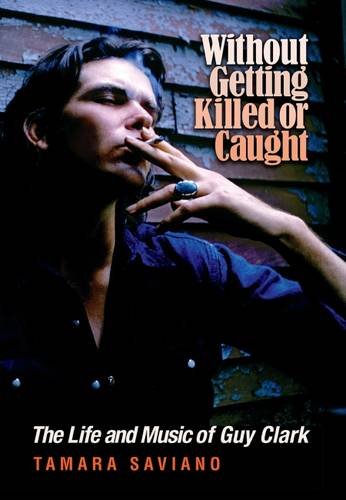Artist: Tamara Saviano
Album: Without Getting Killed or Caught: The Life and Music of Guy Clark
Label: Texas A&M University Press
Release Date: 10/1/2016

Guy Clark, the handsome, charismatic and poetic Texan who penned such memorable tunes as “Desperados Waiting for a Train,” “L.A. Freeway” and “Baby I’m Yours” spent much of his life in the company of—and to an extent, the shadow of—his dear friend and fellow hard-partier Townes Van Zandt. Van Zandt (“Pancho and Lefty,” “If I Needed You,” “Marie”) has several biographies under his tombstone, but now writer, PR representative and record producer Tamara Saviano has produced the first American Clark biography, which, while notably friendly, seems definitive.
Guy Clark newer outgrew his Texas roots, and both his music and his posse reflected his origins, despite the decades spent in Los Angeles and Nashville where he earned a living as a songwriter. Friends Billy Joe Shaver, Ray Wylie Hubbard, Kris Kristofferson, Vince Gill, Joe Ely, Bobby Bare, Lyle Lovett, John Hiatt and protégés Steve Earle, Emmylou Harris and Rodney Crowell surrounded Clark in one way or another his whole life. It would certainly seem that Clark shared many a bottle, joint and young lady with Townes Van Zandt, up to and probably including Clark’s wife, Susanna Talley, who took to her bed upon Van Zandt’s death and never really arose from it.
While, personally, I’ve never quite understood why so many people put up with Townes Van Zandt’s antics and addictions (although many certainly did), Saviano paints a very different picture of Guy Clark: a warm, caring, loyal, talented and generous individual who knew how to write a song, paint a picture, build a guitar and have fun. A perfectionist poet, Clark never put his pen down early, saying “Good enough”; every song received microscopic tinkering, as his many co-writers discovered, but his many gems shone as a result.
His reluctance to compromise meant Clark could sometimes be difficult. Saviano recounts a radio station pitch, where Clark politely asked if he could smoke at the table. When someone from the station objected, Clark responded “Well, then, fuck y’all,” and sat elsewhere in the restaurant, puffing on his home-rolled cigarette. His handler told the station personnel, “Well, this is the Guy Clark experience. I hope you consider playing some of his music.” More often than not, however, Clark exhibited generosity and compassion, making and keeping friends and admirers for life.
Author Tamara Saviano had a long, multifaceted relationship with Clark: an unabashed fan, publicity manager for at least a couple of his albums, biographer, record producer (of the Grammy-nominated This One’s for Him: A Tribute to Guy Clark) and, undeniably, friend and confidant, she remained loyal. In the Acknowledgements, Saviano quotes Rodney Crowell’s advice to her: “If you want to write honestly about Guy and Susanna, you need to go to the dark side.” I believe that out of love and respect, Saviano may have gone into the shadows, but not into the dark in several areas, including Clark’s marriage. Clark’s long, complicated relationship with the talented and torn Susanna Talley (and their entwined relationships with Townes Van Zandt) drove much of his behavior and quite a bit of his writing, including the memorable album My Favorite Picture of You, and Saviano’s reporting has the feel of one who’s deliberately avoiding anything which might be deemed sensational; the only problem is, the truth probably was sensational—Clark lived a full damned life. For example, Clark had a love affair with—among several others at the same time—Bunny Talley, Susanna’s kid sister and roommate. When the 26-year-old Bunny unexpectedly committed suicide, Clark showed up for the funeral and, before the burial, began his relationship with Susanna, whom he then barely knew.
The book has a hundred or more reproductions of photographs, drawings, notebook pages, song lyrics and journal entries which truly bring Clark’s life history alive, and the facts appear to be beyond reproach. If you have any curiosity at all about Guy Clark or the crazy lives that many singer/songwriters—especially the Texans—lived back in the 20th Century, Without Getting Killed or Caught is probably a good place to start learning. It’s a great read.
—Suzanne Cadgène







Be the first to comment!